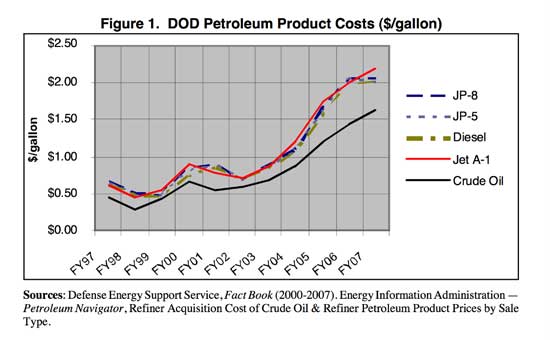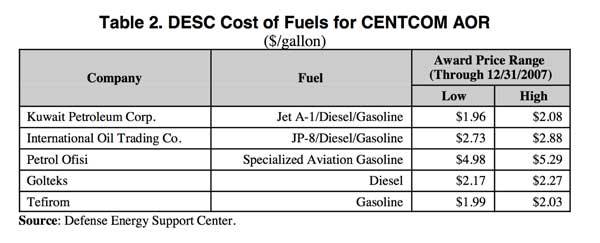09/30/2010 – This posting begins a three part series of the Honorable Bill Anderson’s examination of how to deliver energy to the deployed warfighter. By enhancing the ability of the deployed force to self-sustain, a revolution in combat logistics can be generated.
As Bill Anderson underscores:
A more heavily armored target incentivizes the enemy to develop more lethal weapons. Major General Rick Lynch, who commanded a division in Iraq, noted in an interview with USA Today that the MRAP has forced insurgents to build bigger and more sophisticated bombs. Of course, bigger bombs are harder to make and deploy…giving coalition forces a better opportunity to catch the insurgents. However, if the enemy is successful, coalition fighting forces pay the price.
The answer is simple…the risk only goes away when vehicles come off the road. The vehicles only come off the road if they are no longer required to carry cargo to the front lines.
And as Anderson emphasizes, this capability is within reach.
Once Part Three is posted, the complete article will be published as a SLD special report in our power projection series in PDF format for downloading by readers.
***
Delivering Energy at the Tip of the Spear (Part One)
By Hon. Bill Anderson
Energy, the lynchpin of the battlefield
It has been said since the time of Napoleon that an Army moves on its stomach. It is probably safe to say those words are as accurate today as they were centuries ago, and will likely remain accurate for centuries to come.
Increasingly, however, in today’s modern and ever-evolving battle space Soldiers, Sailors, Airman and Marines cannot move at all, not by land, by sea, by air, in space or in cyberspace, without significant amounts of energy (in the form of both liquid fuel and electricity). In fact, the modern war fighter is unable to project power without adequate….and that means significant…amounts of energy.
This fact is not new-found information, nor is the fact that delivery of energy to the battle space is an incredibly expensive endeavor, both in financial terms and, more importantly, from the perspective of loss of life and limb.
Now, if delivering energy to the troops was as simple as flipping a light switch or a quick trip to the local service station for a fill-up, the military’s energy supply chain would be quite mundane. Unfortunately, our war fighters don’t live in that kind of a world. Their activities are often conducted in remote and hostile environments, far from the delivery points for traditional energy sources, and certainly complicated by the enemy, intent to disrupt, destroy and take life.
Challenges related to delivering fuel to the battle space have sparked debate among various experts for years now as to the financial cost of fuel delivered to the war fighter. The debate has raged within the Pentagon over the exact formula to calculate the fully burdened cost of fuel, with DoD specialists and a cadre of outside experts providing various methodologies to arrive at the exact number.
The calculation of the fully burdened cost of fuel certainly varies depending on delivery method and location, and can range from tens to hundreds of dollars per gallon delivered to point of use. Yet after years of debate and analysis, we have yet to arrive at consensus as to the true fully burdened cost of fuel delivered down range. And while the analysis drags on, the cost to the taxpayer continues and the toll on lives and families weighs heavier by the day.
This situation brings to mind the sage advice provided by General Colin Powell in his well-distributed “A Leadership Primer”. The General warns that excessive delays in the name of information gathering breeds “analysis paralysis”. And procrastination in the name of reducing risk actually increases risk.
Factoring in the real cost of fuel delivery
Now, with that in mind, look beyond the simple financial cost of fuel delivered to the front lines…factor in the human costs…the lives and limbs of American warriors who man the convoys that deliver fuel, and by the way…water (hold that thought, as it becomes important later)…to forward operating bases. The “financial” fully burdened cost of fuel quickly becomes almost irrelevant in comparison to the costs to our war fighters, their families and our country in terms of loss of promise from lives cut short manning the supply lines. Although coming to grips with the true cost of energy delivered to the battlefield is indeed important, we know enough now to draw the most important conclusions:
- Delivering fuel to the front lines is extremely expensive in dollar terms;
- The human cost is absolutely unacceptable.
These two factors alone…following General Powell’s approach to decision making…lead to only one conclusion. That is, we have enough information now…and probably did several years ago…to suggest it is imperative to identify, develop, test and deploy self-contained alternative energy systems to the battle space with all urgency.
 Credit: CRS Report on Fuel Costs in Iraq
Credit: CRS Report on Fuel Costs in Iraq
So, using a bit of General Powell’s logic, let’s do some math and see what it tells us. Ignoring the up-front capital cost to acquire a diesel generator for a moment, focus simply on the variable fuel cost to operate the unit. A 10 kilowatt generator set will typically burn about 1 gallon of fuel per hour. At a cost of $2.60 per gallon, that machine will provide power at a fuel cost of about $0.26 per kilowatt hour…probably not all that bad for emergency backup power.
Now, let’s take a look at what it would cost to provide a kilowatt hour of electricity (primary power) from such a unit on the battlefield. I’ve often heard that it is a general rule of thumb that it takes 7 gallons of fuel to deliver one gallon of fuel to a forward operating base…so let’s use that rule of thumb for the moment. At the same $2.60 per gallon, the fully burdened cost to deliver one gallon of fuel to a forward unit would equate to $20.60 per gallon. Now, run that gallon of fuel through our generator. We are now producing electricity at over $2.00 a kilowatt hour. Imagine receiving that electric bill at your home in next month’s mail!
So, what’s the point of the math? Well… let’s compare the opportunity presented here to the billions of dollars that were required to be spent in the rapid development and deployment of the fleet of Mine Resistant Ambush Protected (MRAP) vehicles. On May 8, 2007 Defense Secretary Robert Gates said acquisition of MRAPs was DoD’s highest priority, with $1.1 billion earmarked for MRAP in FY 2007. Now, no one is going to deny the best equipment to our warrior heroes who put themselves in harm’s way…especially since at the time of that decision. Improvised Explosive Devices (IEDs) were causing more than 60% of US deaths in Iraq.
However, a more heavily armored target incentivizes the enemy to develop more lethal weapons. Major General Rick Lynch, who commanded a division in Iraq, noted in an interview with USA Today that the MRAP has forced insurgents to build bigger and more sophisticated bombs. Of course, bigger bombs are harder to make and deploy…giving coalition forces a better opportunity to catch the insurgents. However, if the enemy is successful, coalition fighting forces pay the price.
The answer is simple…the risk only goes away when vehicles come off the road. The vehicles only come off the road if they are no longer required to carry cargo to the front lines.
 Credit: CRS Report on Fuel Costs in Iraq
Credit: CRS Report on Fuel Costs in Iraq
Generating power at the point of use
So, if the majority of over-the-road cargo is fuel and water…the only logical answer is to generate power and process clean water at the point of use so that these resources no longer have to be hauled along dangerous roads. It would, of course, be an added bonus if the acquisition of these alternative power generation/water purification units could be offered with minimal impact to taxpayer pocketbooks. More on that concept later.
Frontline commander recognition of the hazards associated with the battlefield supply chain has been well documented. Former US Air Force Chief of Staff T. Michael “Buzz” Moseley, while in a previous role as Commander, US Central Command Air Forces, planned and executed some of the most successful air campaigns in both Afghanistan and in Iraq. In executing these “joint” combat operations, he recognized the risks of ground-based transport of supplies. General Moseley therefore shifted a significant portion of supply delivery to the air…reducing risks to ground forces and reducing the potential for loss of the materials, albeit at a higher cost of delivery.
His decision reduced the overall volume of inventory across the roads while at the same time increased the percentage of delivery volume comprised of fuel and water. Overall, this decision resulted in not only a reduced threat to our troops, but also an exponential reduction in delivery times of the critical supplies.
Possibly the most reported acknowledgement of the fuel/water delivery problem is the July 25, 2006 request by then Al-Anbar Commander, USMC Major General Richard Zilmer. He saw first-hand the significant amounts of fuel and water moved in the battle space by road…with some estimates suggesting 70% or more of material moved being fuel and water…presented an unnecessary and unacceptable risk to our military forces.
MG Zilmer’s solution? A request for 183 renewable energy systems of various power capacities for deployment in Al-Anbar. The logic was as brilliant as it was simple…and it is exactly what is stated above. That is, the best way to reduce over-the-road casualties is to reduce the number of vehicles…and the personnel required to operate and protect those vehicles… on the road.
Regrettably, as has been reported, in June of 2007, almost a year after MG Zilmer’s original request, it was rejected by the office of the Joint Chiefs of Staff on the grounds of cost and uncertain technologies. It was said that the technology was not mature enough to deploy on the battlefield. Now, how ironic is it that shortly before the Pentagon denied the Marines’ request for deployable renewable energy systems it embarked on that massive program to develop and field the MRAP, a technology that wasn’t just immature… it did not even exist.
MG Zilmer even provided a set of performance standards that would allow the private sector to tailor solutions for the identified need. Those standards are:
- Ability to operate in cold to tropical, wet to dry environments;
- Due to military reliance on JP-5 and JP-8 fuels, any generators or backups must handle these fuels;
- Power output must cover a range of 100-240 volts and have enough storage capacity to run for a minimum of 24 hours;
- Ease of movement of the equipment…to trouble spots and anywhere in the theater.
Fortunately, even though MG Zilmer’s request was denied, some work has been done to identify distributed alternative power generation options. A number of technical and business teams within the US military have been working this issue for some time. As one example, recently, the US Air Force announced award of a $3.5 million contract to a partnership of Lockheed Martin and Sky Built Power to develop a containerized Integrated Smart-Bear Power System. Obviously, moving the ball forward in this important area is critical.
But, you really have to ask yourself whether there isn’t something available today…ready for immediate deployment…that can begin addressing this problem now. The answer is yes there is. A portable renewable power unit with energy storage capability has been developed, tested and has proven itself in initial deployments in harsh battlefield conditions.

